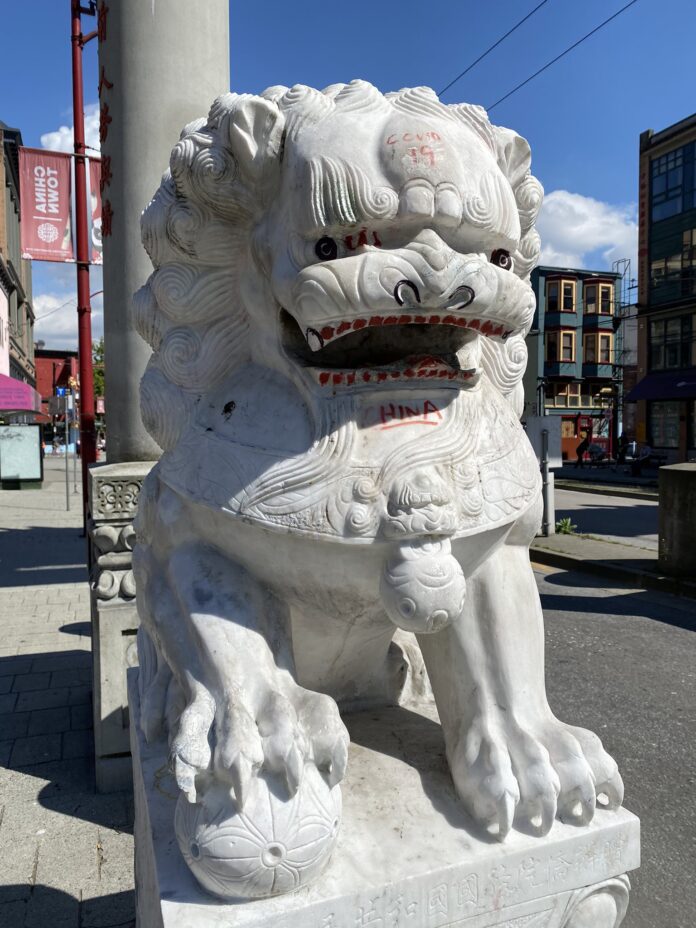Chinatown, Vancouver; Photo by Andres Rodriguez via Flickr Creative Commons
Vancouver has experienced a noticeable spike in graffiti since the beginning of the COVID-19 pandemic. According to CBC, “city administrators say the problem is citywide and it has been hard to keep up with the amount of tagging taking place… But the hardest-hit neighborhoods are Chinatown, the Downtown Eastside and Strathcona.”
According to the City of Vancouver, “property owners are required to remove unauthorized graffiti within 10 days of receiving a notice.” If they fail to due so, CBC says “the city will do it for them — and forward them the bill.”
“Between March and August 2020, around 2,300 businesses had to remove external graffiti, [a 67% increase compared to the year before,]” CBC reports. “Businesses in Chinatown are paying up to $3,000 per month to keep their buildings clean, compared to around $2,000 per month before the pandemic began.”
Unfortunately, Vancouver’s Chinatown is no stranger to an increase in racist graffiti as well. Global News reported in May that “COVID-19, China, and goof were written in red on the iconic lions at […] Millennium Gate.” Earlier that month, Global News also reported a hate crime at the Chinese Cultural Centre on the Downtown Eastside: “The suspect […] walked into the centre’s courtyard […] and defaced four large windows with what police call ‘disturbing, racist remarks towards the Asian community.'”
Though the CBC article doesn’t reference anti-Asian graffiti specifically, even non-racist tags are extremely worrisome to business owners — in part because they are responsible to have it cleaned within a week and a half of its report. In May, the City of Vancouver acknowledged the uptick in graffiti, announcing in a COVID-19 update that “unauthorized graffiti is a community issue and is best addressed using a collaborative and holistic approach.”
But Jordan Eng, president of the Chinatown area’s Business Improvement Association tells CBC that businesses in his neighborhood feel the issue is “a low priority for city leaders.” Though the city “doesn’t hesitate to hold property owners accountable,” Eng says: “[Graffiti] is a problem and if people get caught […], they [just] get a slap on the wrist and told not to do it again.”
Councillor Pete Fry, who lives in the Strathcona neighborhood, tells CBC the problem may be hard to fix. Because the city “can’t afford to increase the police budget for prevention… it might have to think of more creative solutions.” He suggests sanctioned areas for graffiti.
Theodora Lamb, executive director of the Strathcona Business Improvement Association which also covers Downtown Eastside says, “[Business owners have had their fill of tags appearing on walls in both areas.] I think [they’re] being tested like they’ve never been tested before. And that’s saying a lot.”
On the other hand, “reformed tag writer” Drew Young shares with CBC that “there isn’t one reason for the sharp increase in graffiti, but the pandemic plays a large part in it.” He says, “I’m sure a lot of these kids are out of work, super broke and pissed off. They just want to take a piece of their city back.” He argues that we are “bombarded by messages of corporate nature non-stop” and “for many young folks, graffiti represents the democratization of putting out their messages as well.”
Yet regardless of what these messages are, they represent a growing issue for business owners in Chinatown. A February report by CBC notes even in pre-pandemic times that “half of [Chinatown Business Improvement Association’s budget is allocated to] measures like graffiti removal and security patrols. In a BIA survey, business owners also named cleanliness, graffiti and safety as their chief concerns.”
Calling on city officials to “beef us policing and introduce other improvements”, Eng was then optimistic. “Property taxes have gone up quite substantially this year, so we’re asking the question: ‘What is coming to Chinatown? How are you going to help us keep our streets clean so when people come […], they feel invited [instead of coming once and deciding], ‘I don’t want to go again?‘”
Back then, Simon Fraser University planning professor Andy Yan called Chinatown “a neighborhood of sanctuary” that could be “an example for the city’s future.” But eight months later, Chinatown and Vancouver now face unforeseen woes as businesses work in the meantime towards a possibly “cleaner” — but more expensive — future.
AsAmNews has Asian America in its heart. We’re an all-volunteer effort of dedicated staff and interns. Check out our new Instagram account. Go to our Twitter feed and Facebook page for more content. Please consider interning, joining our staff, or submitting a story.


